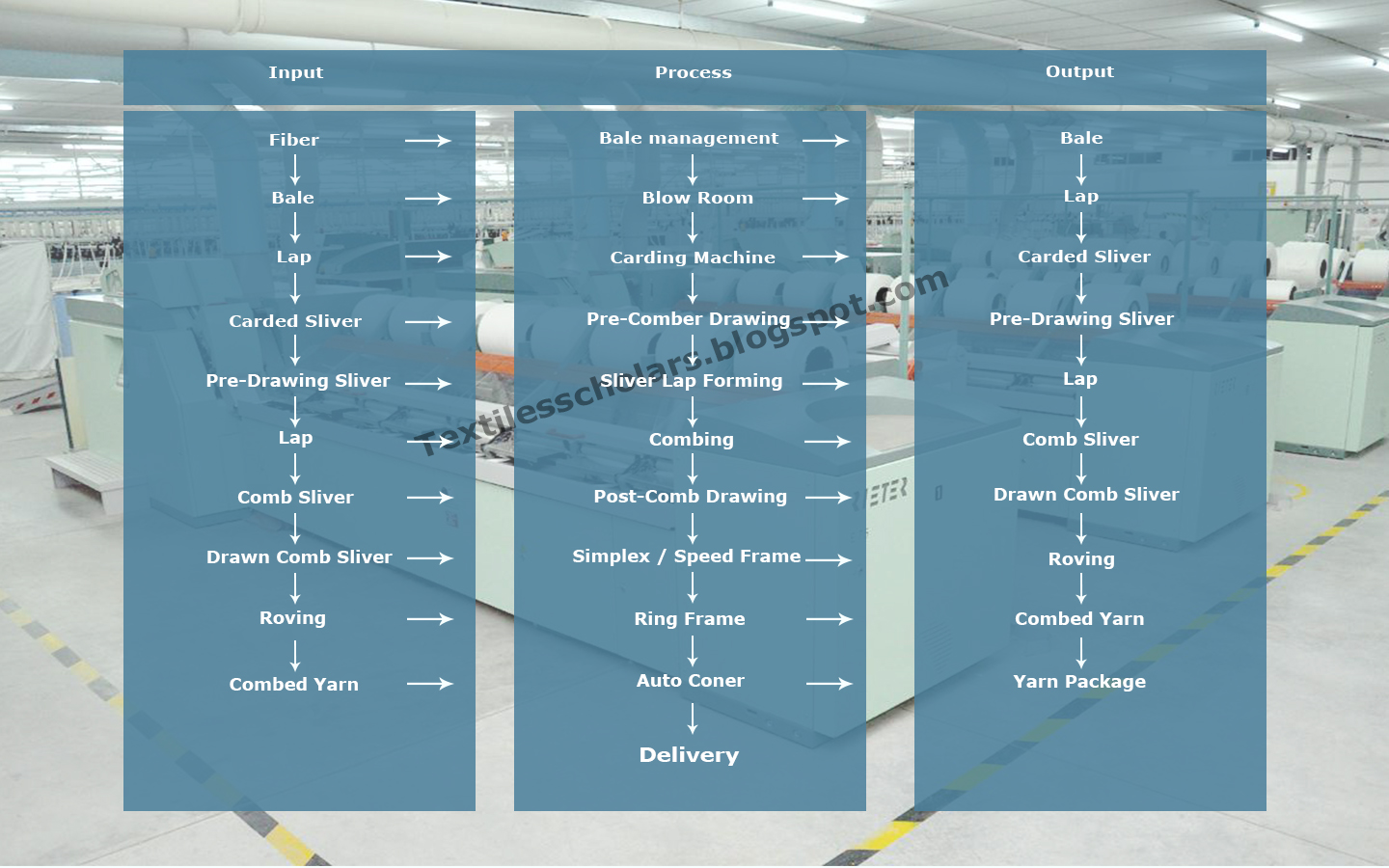In the spinning process, two types of yarn are mostly manufactured, carded yarn and combed yarn. The combed yarn is more precious and soft compared to the carded yarn. But combed yarn manufacturing is a time-consuming process than others. The quality of combed yarn is very high and its only used to make high-quality fabrics or finer fabrics.
Flow chart of combed yarn with different processes:
Input → Process → Output
↓
Fiber → Bale Management → Bale
↓
Bale → Blow Room → Lap
↓
Lap → Carding Machine → Carded Sliver
↓
Carded Sliver → Pre-Comber Drawing → Pre-Drawing Sliver
↓
Pre-Drawing Sliver → Sliver Lap Forming → Lap
Pre-Drawing Sliver → Sliver Lap Forming → Lap
↓
Lap → Combing → Comb Sliver
↓
Comb Sliver → Post-Comb Drawing → Drawn Comb Sliver
↓
Drawn Comb Sliver → Simplex / Speed Frame → Roving
Drawn Comb Sliver → Simplex / Speed Frame → Roving
↓
Roving → Ring Frame → Yarn
↓
Yarn → Auto Coner → Yarn Package
↓
Delivery
Process description of spinning:
- Bale Management: Fiber is collected from the cotton plant. After that, all the fiber are processed to remove different types of large dust like plant leaf, soil and other impurities from the fiber. Finally, fiber bale is made with weight ( 218 to 225 kg ) and sizes ( 1.400 X 0.53 X 0.69 m ). Generally, the bale is a compressed lint after ginning which is tied with wire.
- Blow Room: Blow room is the second step of spinning where the bale is opened and arrange one by one according to bale information for fiber mixing. In the bale, there is some information are recorded like color grade, weight ( 218 to 225 kg ), sizes ( 1.400 X 0.53 X 0.69 m ), batch number etc. The objective of this process produces the fiber lap.
- Carding / Carding Machine: The lap is supplied to the carding machine to produce carded sliver. The objective of this process to straight the fiber and remove the short fiber.
- Pre-Comber Drawing: As the carded sliver is unsuitable for feeding to the comber machine, so Pre-Comber drawing is done. For finer yarn production short fiber is removing by this process.
- Lap Forming: After that, a small and very thin lap sheet is produced for combing from the pre combed sliver.
- Combing: The small and thin lap sheet is passed through the comber machine to produce combed sliver. This sliver is more soft and fluffy than a carded sliver.
- Post-Comb Drawing: Post-comb drawing is done for making the final drawn comb sliver.
- Simplex / Speed Frame: The drawn sliver is processed into the simplex/speed frame to produce roving yarn which is little larger diameter than final yarn. The roving yarn is made without twist and its strength is very low.
- Ring Frame: Ring frame machine is used to twist the roving yarn and produced the finished yarn. By this process, yarn gets good strength for twisting.
- Auto Coner: Basically, Auto coner is used for making different length and size cone package. After that yarn is ready for delivery and used.
Thank you for your patient reading. Is the article helpful? Please, share this article with others.
Process flow chart of spinning | Process flow chart of combed yarn
 Reviewed by Mustaqim-Ul-Alam
on
February 10, 2019
Rating:
Reviewed by Mustaqim-Ul-Alam
on
February 10, 2019
Rating:
 Reviewed by Mustaqim-Ul-Alam
on
February 10, 2019
Rating:
Reviewed by Mustaqim-Ul-Alam
on
February 10, 2019
Rating:






